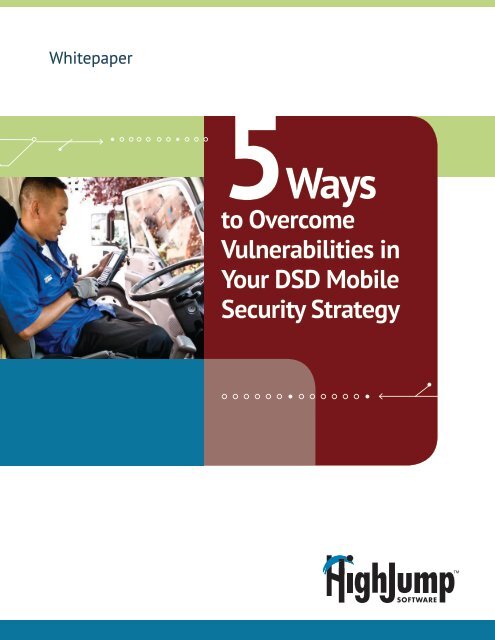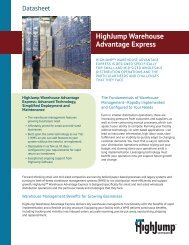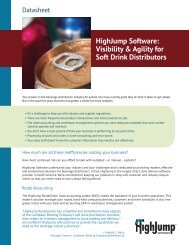to Overcome Vulnerabilities in Your DSD Mobile Security Strategy
to Overcome Vulnerabilities in Your DSD Mobile Security Strategy
to Overcome Vulnerabilities in Your DSD Mobile Security Strategy
Create successful ePaper yourself
Turn your PDF publications into a flip-book with our unique Google optimized e-Paper software.
Whitepaper<br />
5Ways<br />
<strong>to</strong> <strong>Overcome</strong><br />
<strong>Vulnerabilities</strong> <strong>in</strong><br />
<strong>Your</strong> <strong>DSD</strong> <strong>Mobile</strong><br />
<strong>Security</strong> <strong>Strategy</strong>
5 Ways <strong>to</strong> <strong>Overcome</strong> <strong>Vulnerabilities</strong> <strong>in</strong> your<br />
<strong>DSD</strong> <strong>Mobile</strong> <strong>Security</strong> <strong>Strategy</strong><br />
Introduction<br />
Thanks <strong>to</strong> advances <strong>in</strong> mobile technology, you hold a world<br />
of <strong>in</strong>formation <strong>in</strong> your hands. Merely a decade ago, the notion<br />
of hold<strong>in</strong>g a full-powered computer <strong>in</strong> your palm was a novel<br />
idea. Today, it’s your bus<strong>in</strong>ess partner—and productivity would<br />
plummet without it.<br />
Anyone who works <strong>in</strong> the direct s<strong>to</strong>re delivery (<strong>DSD</strong>) environment<br />
understands the value <strong>in</strong> the progression of mobile technology<br />
and wireless access. The pre-sale environment is <strong>in</strong>creas<strong>in</strong>gly<br />
def<strong>in</strong>ed by low-cost wireless order transmission. And a delivery<br />
process that used <strong>to</strong> require 48 hours has been slashed <strong>in</strong> half,<br />
driv<strong>in</strong>g the market—<strong>in</strong>clud<strong>in</strong>g your cus<strong>to</strong>mers—<strong>to</strong> demand<br />
faster, more accurate and more cost-effective service. The <strong>DSD</strong><br />
distribution cha<strong>in</strong>, from plants <strong>to</strong> wholesaler warehouses and sales<br />
departments, <strong>to</strong>day <strong>in</strong>sists on <strong>in</strong>creased productivity and near<br />
real-time communications: on-the-spot messag<strong>in</strong>g capabilities so<br />
products flow <strong>to</strong> the right places, exactly when they’re needed and<br />
<strong>in</strong> the precise quantities desired.<br />
While the rewards of mobile sales and delivery management<br />
are notable, there are new risks <strong>to</strong> consider. In fact, the risks<br />
related <strong>to</strong> mobile devices are <strong>in</strong>creas<strong>in</strong>g. There are more and<br />
more attacks aimed at snoop<strong>in</strong>g wireless 802.11 (“WiFi”)<br />
communications and Blue<strong>to</strong>oth® technology (a wireless<br />
standard for short-range data shar<strong>in</strong>g), and an <strong>in</strong>creas<strong>in</strong>g<br />
number of worms and viruses target<strong>in</strong>g mobile operat<strong>in</strong>g<br />
systems. Just as viruses, worms, and spyware evolved, from<br />
target<strong>in</strong>g floppy disks and spread<strong>in</strong>g through shar<strong>in</strong>g files <strong>in</strong> the<br />
1980s <strong>to</strong> exploit<strong>in</strong>g e-mail and the Web <strong>in</strong> the 1990s, attackers<br />
will cont<strong>in</strong>ue <strong>to</strong> follow technology wherever it goes. <strong>Your</strong><br />
bus<strong>in</strong>ess needs <strong>to</strong> have the right defenses <strong>in</strong> place <strong>to</strong> protect<br />
aga<strong>in</strong>st these threats—malicious viruses, eavesdroppers and<br />
attack exploits that threaten the <strong>in</strong>tegrity and confidentiality of<br />
your <strong>in</strong>formation.<br />
Networks are built <strong>to</strong> facilitate the ease of communication.<br />
They’re based on standards that aim <strong>to</strong> enable the free flow<br />
of <strong>in</strong>formation and access from anywhere. But this <strong>in</strong>creases<br />
complexity and makes them quite vulnerable <strong>to</strong> those who<br />
would tap <strong>in</strong> and destroy data—just because they can. However,<br />
with the right set of <strong>to</strong>ols and proper management, the<br />
potential for danger can be dim<strong>in</strong>ished dramatically. But it does<br />
take an ongo<strong>in</strong>g commitment <strong>to</strong> security.<br />
Because mobile technology leaves the relative security, stability<br />
and comfort found beh<strong>in</strong>d the corporate bricks and mortar, your IT<br />
department must manage and update handheld systems properly.<br />
Every effective security strategy and technology that protects the<br />
core company network and systems can be applied <strong>to</strong> each device,<br />
no matter how small, mobile or dedicated its function.<br />
What You Will Learn <strong>in</strong> This Report<br />
This report highlights the five most common vulnerabilities<br />
that weaken mobile IT security for many bus<strong>in</strong>esses, and what<br />
you should do <strong>to</strong> overcome them. It underl<strong>in</strong>es the importance<br />
of establish<strong>in</strong>g a specific mobile security strategy and describes<br />
the technologies and processes that should be implemented<br />
<strong>to</strong> help ensure device connectivity and availability rema<strong>in</strong> high,<br />
and that the <strong>in</strong>formation resid<strong>in</strong>g on these devices stays private<br />
and secure.<br />
Five Ways <strong>to</strong> <strong>Overcome</strong> <strong>Vulnerabilities</strong><br />
<strong>in</strong> <strong>Your</strong> <strong>DSD</strong> <strong>Mobile</strong> <strong>Security</strong> <strong>Strategy</strong><br />
1 Lack of a Cohesive <strong>Mobile</strong><br />
<strong>Security</strong> Policy<br />
Just as your IT department has security policies <strong>in</strong> place for<br />
corporate servers, desk<strong>to</strong>ps and notebooks, (such as regularly<br />
patch<strong>in</strong>g software, updat<strong>in</strong>g firewall rules and hav<strong>in</strong>g anti-virus<br />
protection <strong>in</strong> place) the same scrut<strong>in</strong>y must be given <strong>to</strong> all<br />
mobile devices that carry and transmit company <strong>in</strong>formation.<br />
The first step is <strong>to</strong> <strong>in</strong>ven<strong>to</strong>ry all mobile devices <strong>in</strong> the field, who<br />
is assigned <strong>to</strong> each, and how they’re be<strong>in</strong>g used. The goal is<br />
<strong>to</strong> establish a basel<strong>in</strong>e security framework <strong>to</strong> ensure that the<br />
devices and <strong>in</strong>formation are properly ma<strong>in</strong>ta<strong>in</strong>ed, and that they<br />
m<strong>in</strong>imize risk <strong>to</strong> the corporate network and applications when<br />
they connect.<br />
Vital aspects of your policy should <strong>in</strong>clude:<br />
• Decid<strong>in</strong>g which devices and/or users will be permitted <strong>to</strong><br />
connect <strong>to</strong> <strong>in</strong>ternal applications and communication servers<br />
and how they’re authenticated (by the device, assigned IP<br />
address, and/or username and password, etc.)<br />
• Establish<strong>in</strong>g policies on password strength (how many<br />
characters, how many need <strong>to</strong> be upper-case, the mix of<br />
numbers and letters, etc.)<br />
• Determ<strong>in</strong><strong>in</strong>g how data will be protected (encryption,<br />
password access <strong>to</strong> the device, etc.) on the device<br />
• Establish<strong>in</strong>g security dur<strong>in</strong>g transmission. If you’re rely<strong>in</strong>g<br />
on a private network carrier that encrypts data transmission,<br />
you may already have this vulnerability solved. If users<br />
connect remotely from WiFi hotspots, or transmit by<br />
synchroniz<strong>in</strong>g from remote PCs, you’ll want <strong>to</strong> consider<br />
deploy<strong>in</strong>g a virtual private network (VPN).<br />
2
5 Ways <strong>to</strong> <strong>Overcome</strong> <strong>Vulnerabilities</strong> <strong>in</strong> your<br />
<strong>DSD</strong> <strong>Mobile</strong> <strong>Security</strong> <strong>Strategy</strong><br />
You’ll also need formal policies that mandate how and when<br />
mobile devices will receive application and operat<strong>in</strong>g system<br />
security patches and updates, as well as how they’re protected<br />
from malicious software, such as viruses, worms and Trojan<br />
horses. These suggestions are a good start<strong>in</strong>g po<strong>in</strong>t. But your IT<br />
department needs <strong>to</strong> be your central ally when establish<strong>in</strong>g your<br />
mobile security policies and strategy. Lean on IT for advice.<br />
2 Ignor<strong>in</strong>g<br />
It doesn’t matter how many controls companies put <strong>in</strong><strong>to</strong><br />
place: data encryption, secure network transmission, anti-virus<br />
software, strong passwords: all of these can be circumvented<br />
if employees and contrac<strong>to</strong>rs aren’t made aware of the risks.<br />
Lack of understand<strong>in</strong>g is one of the primary reasons why many<br />
users view security software and policies as barriers that slow<br />
down their efficiency. The fact is that security actually enables<br />
organizations <strong>to</strong> safely conduct bus<strong>in</strong>ess remotely, <strong>in</strong> ways that<br />
don’t jeopardize the availability or <strong>in</strong>tegrity of <strong>in</strong>formation and<br />
networks. By educat<strong>in</strong>g users through e-mail newsletters or<br />
tra<strong>in</strong><strong>in</strong>g sessions, they’ll understand the risks <strong>to</strong> your bus<strong>in</strong>ess<br />
when security policies aren’t followed. Few people understand<br />
the risks associated with mobile viruses, or with connect<strong>in</strong>g <strong>to</strong><br />
the network from a public hotspot or café. Studies show that<br />
users who experience security tra<strong>in</strong><strong>in</strong>g are less likely <strong>to</strong> visit<br />
potentially malicious Web sites, share their password with a<br />
crafty social eng<strong>in</strong>eer, or make other security-related mistakes.<br />
3 Not<br />
<strong>Security</strong> Awareness<br />
Tra<strong>in</strong><strong>in</strong>g<br />
Secur<strong>in</strong>g Data <strong>in</strong><br />
Transmission<br />
How you secure data as it is transmitted <strong>to</strong> and from your<br />
mobile devices and corporate applications depends largely on<br />
the type of network you utilize. If you’re us<strong>in</strong>g a private network,<br />
such as those provided by the major telecommunication<br />
carriers, your transmissions may be encrypted already and will<br />
be much more difficult for potential attackers <strong>to</strong> identify. If<br />
devices are connect<strong>in</strong>g from external hotspots, the only safe<br />
assumption is that anyone can access, read and modify what’s<br />
be<strong>in</strong>g transmitted. In addition, if users are connect<strong>in</strong>g <strong>to</strong> home<br />
or remote PCs, synchroniz<strong>in</strong>g and then transmitt<strong>in</strong>g data, that<br />
traffic also can be accessed easily. In these cases, you’ll need<br />
<strong>to</strong> deploy a VPN. VPNs help <strong>to</strong> authenticate that the user<br />
access<strong>in</strong>g your network or applications is legitimate; then,<br />
all communication that travels between the device and your<br />
network is securely encrypted with<strong>in</strong> the VPN “tunnel.” Now,<br />
anyone try<strong>in</strong>g <strong>to</strong> eavesdrop on the communication will see<br />
only gibberish because it’s scrambled on the device before it’s<br />
transmitted and decrypted on the other end of the connection.<br />
Anyone without VPN credentials is kept out.<br />
4 Not<br />
Secur<strong>in</strong>g <strong>Mobile</strong><br />
Device Data<br />
News s<strong>to</strong>ries about large corporations, government agencies<br />
and other organizations los<strong>in</strong>g notebooks, handheld devices<br />
and removable s<strong>to</strong>rage media abound. One of the most crucial<br />
aspects of your security strategy needs <strong>to</strong> be putt<strong>in</strong>g <strong>in</strong><strong>to</strong> place<br />
defenses that protect not only the device itself, but also the<br />
<strong>in</strong>formation it conta<strong>in</strong>s, <strong>in</strong>clud<strong>in</strong>g user names and passwords<br />
that could be used <strong>to</strong> access even more sensitive corporate<br />
<strong>in</strong>formation and network systems.<br />
First, these devices are easily lost. So, make certa<strong>in</strong> that<br />
any sensitive <strong>in</strong>formation users don’t need isn’t s<strong>to</strong>red on<br />
handhelds: cus<strong>to</strong>mer numbers, passwords and sensitive f<strong>in</strong>ancial<br />
<strong>in</strong>formation. Whatever is confidential and you wouldn’t want<br />
competi<strong>to</strong>rs or bus<strong>in</strong>ess partners <strong>to</strong> access should not reside<br />
permanently on the device or persist there any longer than<br />
necessary. Likewise, whenever upgrad<strong>in</strong>g <strong>to</strong> a new device, take<br />
care <strong>to</strong> remove all <strong>in</strong>formation before the device is discarded.<br />
Second, utiliz<strong>in</strong>g user names and passwords goes a long way <strong>to</strong><br />
keep<strong>in</strong>g unauthorized users from access<strong>in</strong>g applications on the<br />
device. Check with your <strong>DSD</strong> software provider <strong>to</strong> see if it offers<br />
capabilities <strong>to</strong> centrally manage user passwords. If necessary,<br />
consider <strong>in</strong>stall<strong>in</strong>g third-party software that will enable you <strong>to</strong><br />
centrally manage user names, or PINs, that can be used <strong>to</strong> lock<br />
down the device when it hasn’t been used for several m<strong>in</strong>utes.<br />
Ideally, look for software that provides the ability <strong>to</strong> wipe the<br />
device clean after a certa<strong>in</strong> number of <strong>in</strong>valid log<strong>in</strong> attempts.<br />
But be careful: these controls need <strong>to</strong> be centrally managed. If<br />
users have the ability <strong>to</strong> set and change their own passwords,<br />
managers and even the IT team may not be able <strong>to</strong> access<br />
<strong>in</strong>formation on the device should the employment status of<br />
the user change. Lock<strong>in</strong>g down the device will not protect the<br />
data if it is s<strong>to</strong>red on removable media. Removable media cards<br />
can be <strong>in</strong>serted <strong>in</strong><strong>to</strong> another device <strong>to</strong> ga<strong>in</strong> access <strong>to</strong> your data.<br />
Make sure sensitive data is s<strong>to</strong>red <strong>in</strong> an encrypted format or<br />
s<strong>to</strong>rage card encryption is used.<br />
At a fundamental level, all wireless communications, <strong>in</strong>clud<strong>in</strong>g<br />
Blue<strong>to</strong>oth capabilities, need special attention. If there’s no need<br />
for users <strong>to</strong> share data with other mobile devices, PCs, or cell<br />
3
5 Ways <strong>to</strong> <strong>Overcome</strong> <strong>Vulnerabilities</strong> <strong>in</strong> your<br />
<strong>DSD</strong> <strong>Mobile</strong> <strong>Security</strong> <strong>Strategy</strong><br />
phones, consider turn<strong>in</strong>g off Blue<strong>to</strong>oth and WiFi capabilities <strong>in</strong><br />
all devices. Attackers have devised many ways <strong>to</strong> ga<strong>in</strong> control<br />
and access Blue<strong>to</strong>oth- and WiFi-enabled devices. Whenever<br />
these capabilities are enabled, the device may broadcast its<br />
presence, mak<strong>in</strong>g it <strong>to</strong>o accessible <strong>to</strong> <strong>in</strong>truders and even mobile<br />
threats, such as Trojans and viruses. While the threat is real only<br />
at close proximity, the threat is still real, especially at hightraffic<br />
locations, such as WiFi hotspots, gas stations, airports,<br />
tra<strong>in</strong> stations and similar locations. When Blue<strong>to</strong>oth connections<br />
are necessary, make certa<strong>in</strong> that users connect only <strong>to</strong> trusted<br />
devices through a process known as “pair<strong>in</strong>g,” <strong>in</strong> which known<br />
users share a PIN <strong>to</strong> establish device connection. Likewise, turn<br />
off adhoc connections for 802.11. The bot<strong>to</strong>m l<strong>in</strong>e is that your<br />
software should have the capability <strong>to</strong> turn off wireless devices<br />
if they’re not <strong>in</strong> use <strong>to</strong> limit availability.<br />
F<strong>in</strong>ally, some <strong>DSD</strong> providers offer the ability <strong>to</strong> remotely<br />
deauthenticate devices. In the event that a device is lost or<br />
s<strong>to</strong>len, and it tries <strong>to</strong> establish a network connection, the<br />
data on the device can be removed and all access privileges<br />
associated with the device revoked.<br />
5 Not<br />
Implement<strong>in</strong>g<br />
Anti-Virus Software<br />
It’s imperative that your anti-virus and bus<strong>in</strong>ess applications<br />
are compatible. Check with your IT department <strong>to</strong> <strong>in</strong>stall an<br />
anti-virus application that is centrally configurable—so every<br />
device has the same high levels of protection. Well-known and<br />
established anti-virus software vendors usually are the best<br />
choice: the software tends <strong>to</strong> be more easily manageable, has<br />
fewer compatibility issues, and the anti-virus updates come<br />
quickly—giv<strong>in</strong>g you swift protection from new threats.<br />
Conclusion<br />
While <strong>DSD</strong> mobile <strong>in</strong>itiatives help w<strong>in</strong> more shelf space, provide<br />
on-the-spot consult<strong>in</strong>g with up-<strong>to</strong>-the m<strong>in</strong>ute <strong>in</strong>formation,<br />
and drive down delivery costs, the security of mobile devices<br />
on which these capabilities depends can’t be overlooked. You<br />
and your IT department should approach the security of your<br />
mobile devices as part of your company’s overall security and<br />
availability strategy. For more <strong>in</strong>formation about provid<strong>in</strong>g<br />
secure <strong>DSD</strong> capabilities, make sure your <strong>DSD</strong> vendor can help<br />
you craft a strategy that enables you <strong>to</strong> accelerate your bus<strong>in</strong>ess,<br />
improve sales marg<strong>in</strong>s, and cut costs—securely.<br />
Attackers are <strong>in</strong>creas<strong>in</strong>gly target<strong>in</strong>g mobile devices. They’re<br />
craft<strong>in</strong>g viruses, spyware and Trojan horses <strong>to</strong> spread via these<br />
devices and <strong>in</strong>fect mobile operat<strong>in</strong>g systems. These malicious<br />
applications can be designed <strong>to</strong> do everyth<strong>in</strong>g they do <strong>to</strong><br />
traditional PCs: destroy software and data, and capture sensitive<br />
<strong>in</strong>formation. Most major anti-virus software vendors now make<br />
security applications designed <strong>to</strong> protect handheld devices<br />
from such <strong>in</strong>festations—and while mobile viruses and snoop<strong>in</strong>g<br />
software aren’t as prevalent <strong>to</strong>day as those aimed at desk<strong>to</strong>ps,<br />
security analysts expect this <strong>to</strong> soon change. Protect<strong>in</strong>g mobile<br />
devices from these threats is essential. You need <strong>to</strong> protect<br />
these devices whenever they’re synchroniz<strong>in</strong>g, connect<strong>in</strong>g at<br />
hotspots, us<strong>in</strong>g Blue<strong>to</strong>oth, or check<strong>in</strong>g e-mail.<br />
© 2005-2008,2011 HighJump Software Inc. All rights reserved. HighJump is a trademark of HighJump Software Inc.<br />
4

















